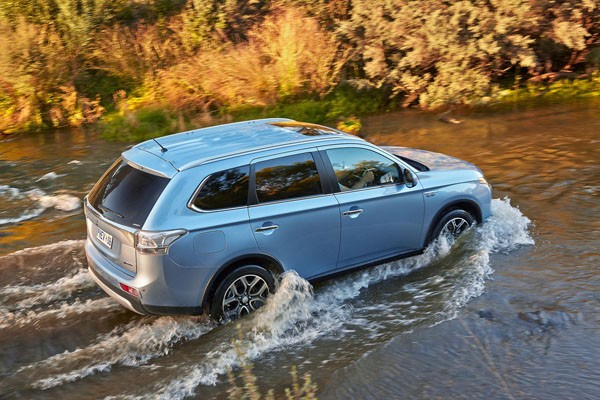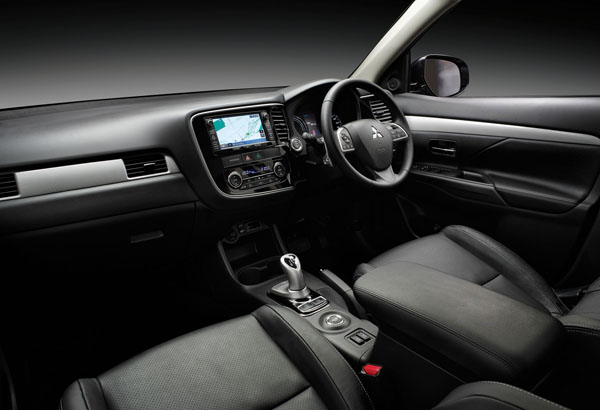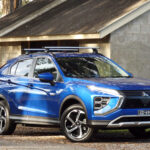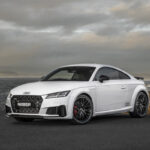 When we reported on the launch of the Mitsubishi Outlander PHEV it was described by the Japanese company as being the first production plug-in hybrid electric SUV in the world.
When we reported on the launch of the Mitsubishi Outlander PHEV it was described by the Japanese company as being the first production plug-in hybrid electric SUV in the world.
At the time our testing had been restricted to a brief on-road drive in and around Canberra. The following day we were able to take the Mitsubishi SUV not only on longer road trips, also did some off-road driving.
We covered 30 kilometres on battery power alone and like all of its type found the Mitsubishi Outlander electric to be eerily quiet, smooth and full of strong torque. Though the battery indicator was still showing about half full, we manually told the vehicle to start the four-cylinder petrol to not only provide drive, but also charge the battery. The plan was to have enough charge in the battery so we could do all our off-road sections on electric power alone.

Petrol consumption, which had previously been sitting at zero, gradually started to rise and fifty kilometres later was sitting at around three litres per hundred kilometres.
(Later testing, without the aid of ‘free’ electricity by way of a power socket, had the Mitsubishi petrol engine running at about six to seven litres per hundred kilometres mainly on open road running. In other words about what you would expect from a turbo-diesel engine in similar circumstances.)
When we first reached the off-road section we felt Mitsubishi had taken us to an area of easy running. Sadly, it’s not unusual for car companies to set a journalists’ SUV drive program on roads that could have been traversed with ease by conventional cars. (They argue that’s all most SUV owners will ever do.)

So we were delighted when we finally found ourselves in real off-road country. Beautiful forests with steep ascents and descents on dirt tracks damaged not only by other vehicles but also by heavy rain and natural drop offs. Followed by a moderately serious river crossing.
The Mitsubishi handled these in the manner of real 4WD, with strong torque courtesy of the electric motors, good traction and reasonably sharp angles it overcame all we threw at it. It did scrape underneath at times, but that’s not unusual in any ‘proper’ off-road driving.
All of this with the silence that’s normal from an electric vehicle.
The battery was, naturally, discharging at a higher rate than in on-road running, though not alarmingly so. After 12 km of heavy-duty work it had dropped from half charge to almost zero. Of course, we had petrol power on standby.
When we stopped for drinks and sandwiches we tested what you could call the on-board charging system. Using a special setting we ran the petrol engine for an hour with the Outlander stationary. Not what you would normally do in the middle of the bush of course, but the engine is still rated as being clean and we were experimenting with what can be done.
We couldn’t establish Mitsubishi’s claim that the engine would give around 80 per cent charge in 40 minutes, achieving about 70 per cent at the end of the hour.
A word of explanation. Mitsubishi says this charging is the sort of thing you might want to do after a long trip which had exhausted the battery, but now wanted to run the PHEV as a pure electric vehicle in tight city conditions. You would stop somewhere clear of the city, charge up its battery using petrol, then continue into the area of potential heavy pollution.
All-in-all a valuable day’s testing – in which the Mitsubishi Outlander PHEV shone. This really is a vehicle of all conditions, a genuine petrol-electric SUV that will meet the needs of many owners.
Priced from $47,490 the Mitsubishi Outlander PHEV is on sale now at most, but not all, Australian Mitsubishi dealers.
Outlander PHEV is only the first of many of its type to come out of Japan. Mitsubishi is one of the world leaders in electric vehicles, it has already launched the pure-electric i-MiEV in Australia. Later we will see other passenger cars and SUVs. Prototype SUVs are are already underway: smaller vehicles, the size of the Mitsubishi ASX with a three-cylinder petrol engine and electric drive; and Pajero type 4WDs with turbo-diesel and electric power.
Others will follow, stay tuned.











